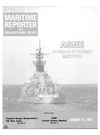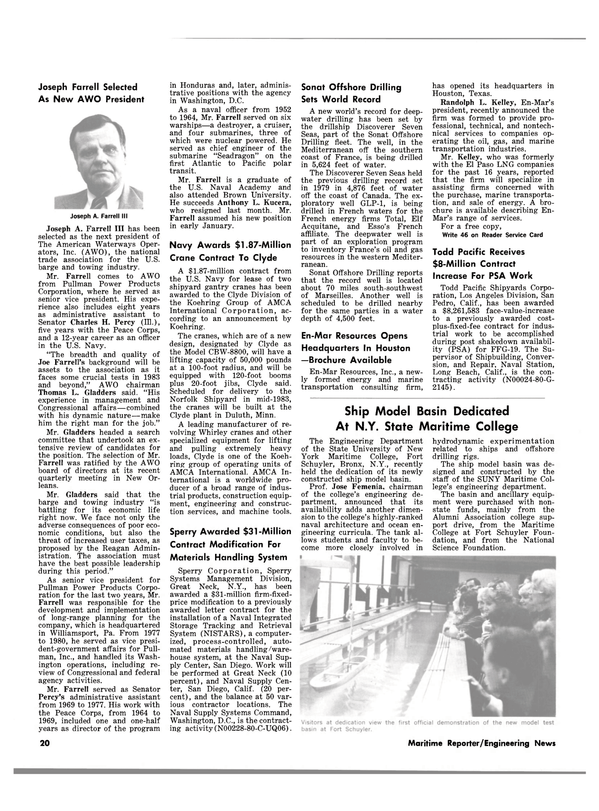
Navy Civil Engineering Lab Completes Studies On Future Pier Designs
The Naval Civil Engineering Laboratory (NCEL), Port Hueneme, Calif., a leading investigator of innovative pier designs for surface combatant ships such as frigates, destroyers, and cruisers, has completed two comprehensive studies to generate new design ideas and to influence future pier construction. One concept — a floating pier — was developed under contract with T. Y.
Lin International, San Francisco.
The other new design — a function- formed pier—was developed under contract with Sidney M.
Johnson & Associated, Union, N.J.
The laboratory's effort to improve pier designs and thereby improve shore support is sponsored by the Naval Facilities Engineering Command (NAVFAC).
The task is part of the Naval Facilities Systems Project, guided by a Navy decision "to acquire, operate and maintain piers which are cost effective and responsive to changing user (new ships') requirements." Duane Davis, NCEL project engineer, said the first steps taken were to identify ship requirements; to analyze current deficiencies and problem areas; and to develop design criteria.
Both NCEL pier proposals incorporate the shore services that will meet the requirements of Navy ships through the 1990s.
The laboratory favors the floating pier concept—it is judged to have many advantages over any pile-supported concept.
NCEL's conceptual design calls for a double-deck floating pier, 1,200 feet long and 75 feet wide.
It can be constructed of two 600- foot modules at an offsite construction yard, and then floated into place. The main, upper deck stands 20 feet above the water line. It contains cargo stairwells, electrical service outlets, and trash wells, and also provides the clear deck required by the Navy.
The lower deck has space for electrical substations, waste holding tanks, vehicle traffic, storage, and solid waste containers.
The NCEL concept also includes the pier's structural system, fender system, anchoring system, and construction methods.
Mr. Davis cited the following advantages of a floating pier: • On-site construction time is reduced because only 58 anchoring piles are driven, while a conventional pile-supported pier requires hundreds of piles. As the pier modules are constructed offsite and floated into place, significant time is saved. Replacing a fixed pier with another fixed pier requires at least 18 months, but out-of-service time could be decreased by 12 months if a floating pier were installed.
• Since the pier rises and falls with the tide, its elevation remains constant. Restraining lines do not require constant tending and utility lines can be shorter.
• A modern fender system contacts the ship at the waterline and remains constantly in position because the pier and the ship move together with the tide.
Fender piles and camels—floating fenders—are eliminated, greatly reducing pier maintenance costs.
• A floating pier is an ideal concept for two-deck configuration.
Two decks provide more flexibility and responsive service than does a wider, conventional single-deck pier. Also, pier functions can be separated efficiently.
• The design is adaptable to a wide range of site conditions. For typical sites, guide/restraining piles are located along the pier centerline. For sites with atypical conditions, other types of mooring/restraining systems can be used.
• The pier modules can be towed to a new site and reinstalled if the need justifies the expense. Prior to relocation, the guide piles are removed, the ramps and utility lines disconnected.
• The design offers significantly better protection from earthquakes than a fixed pier.
The laboratory's new pier concepts were influenced by recommendations emanating from a 1981 Navy workshop on "Pier Designs for Fleets of the 1990s and Beyond." The NAVFAC/ NCEL study group reviewed and evaluated a cross-section of fleet requirements, problems, priorities, and proposals. The workshop structured definitive guidance for NCEL in its designs.
Mr. Davis said plans call for the laboratory to conduct costbenefit studies of the floating pier concept to demonstrate its economic feasibility and operational advantages. A second workshop, scheduled for next summer, will review and critique pier designs generated by NCEL and NAVFAC field divisions.
Read Navy Civil Engineering Lab Completes Studies On Future Pier Designs in Pdf, Flash or Html5 edition of January 15, 1983 Maritime Reporter
Other stories from January 15, 1983 issue
Content
- Aalborg Vaerft Conducts Tank Tests Of New Cruise Liner Model page: 6
- Thomas Marine Delivers Two 38-Foot Police Patrol Boats page: 8
- Todd Pacific Delivers Guided Missile Frigate Reid To The U.S. Navy page: 8
- Kone And Far East-Levingston In Joint Venture For Crane Manufacturing In Singapore page: 10
- CSSRA Urges Adoption Of Canadian Building Policy page: 10
- Leevac Corporation Names Terry Hardouin Planning Manager page: 10
- Tidewater Marine Buys T1 Vessels From Halter Marine For $33 Million page: 11
- A.S.N.E. PUTTING FIRE POWER TO SEA page: 12
- Elliott Awarded Additional Contract For Thruster Unit page: 15
- Roger Ffooks Appointed European Representative For J.J. Henry Firm page: 15
- Battleship New Jersey Is Recommissioned page: 16
- Norshipco's Floating Drydock Titan' Aids In Tunnel Construction Project page: 16
- Aeroquip Names Manager, Contract Administration, For M a r i n e / M i l i t a r y Products page: 17
- Two Ro/Ro's For Saudi Arabia Dedicated At Kockums, Four-Ship Order Valued At $250 Million page: 17
- Navy Civil Engineering Lab Completes Studies On Future Pier Designs page: 18
- New Marine Insurance Brochure Available From Skuld In Norway page: 18
- Dravo Appoints Three Senior Officials In Its Marine Construction Organization page: 19
- $32.6-Million Title XI Sought For Purchase And Rebuilding Of RO/RO page: 19
- SKF Couplings Described In Free 26-Page Full-Color Brochure page: 19
- Joseph Farrell Selected As New AWO President page: 20
- Navy Awards $1.87-Million Crane Contract To Clyde page: 20
- Ship Model Basin Dedicated At N.Y. State Maritime College page: 20
- New Ferry Contract For Over $1-Million Awarded To Offshore Shipbuilding page: 21
- Lykes Ship Sends Data By Satellite-Phone Hookup page: 21
- Oceans '83 Conference Issues Call For Papers page: 21
- Nichols Brothers Yard Starts Work On 265-Foot Split-Hull Hopper Dredge page: 21
- Ehrenfried Of Metritape Presents Paper At SNAME New England Meeting page: 21
- MAN-B&W Diesel Holds Symposium For West Coast Marine Industry Leaders page: 22
- Bruce D. Smith Elected President Of COMSAT Technology Products page: 22
- MacGregor To Equip 30 Barges, 3 Ships Building In Japan For Paraguay page: 22
- Barber President Named Commissioner Of Pilots page: 35
- Bates To Retire As ACL Chairman At End Of '83, —Koch Named Successor page: 35
- $ 5 . 4 - M i l l i o n Navy Contract A w a r d e d Tracor For SSBN Sonar Systems Services page: 36
- Romanelli Joins Fairhaven M a r i n e As Vice President page: 36
- Kelly Named Vice President Of Lykes Pacific Division page: 37
- M a r A d Offers Report On Shipboard Fuel Handling And Conditioning page: 37
- New 15-100 H.P. Barge Spotters Described In Free Literature page: 37
- Lockheed To Build Prototype Vehicles To*' Destroy Naval Mines page: 38
- Coast Guard Publishes Revised Navigation Rules page: 39
- Johnson & Towers Named Alco Diesel Distributor —Literature Offered page: 39
- ASNE Southern New England Discusses Sub Combat Systems page: 41
- MarAd Approves Crowley Acquisition Of Delta Steamship Stock For $96 Million page: 42
- LTI Introduces New System For M o v i n g Ship Sections —Literature A v a i l a b le page: 43
- SNAME-Philadelphia Section Hears Paper On Marine Epoxy Resin Chocks page: 44
- Trellclean Conducts Technical Briefing And Hull-Cleaning Demonstration page: 44
- Uniflite Announces Three Executive Appointments page: 45
- Deep-Notch Tug And Barge Delivered To Energy Transportation page: 45
- Jackup Rig "Sam Noble" Is Christened At Levingston page: 46
- New USCG Pollution Prevention Requirements Effective October 2 page: 46
- Stone Manganese Offers Technical Reports On Fuel Economy And Propellers page: 48
- Burton Delivers 224-Foot Seiner, Sixth Of Seven Foir Van Camp page: 48
- Pan-American Naval Engineers To Hold 1983 Meeting in D.C. page: 48
- Paceco Delivers Railmounted Transtainer Crane To U.S. Army page: 53
- Hoffert Manufacturing Awards Caribbean Cruise At SNAME Exposition page: 58
- Nome Seeks $38.5-Million For Proposed Year-Round Port page: 58
- Bay Shipbuilding Retains W i l l i am Thompson As Washington Representative page: 59
- Bulk Carrier Karnataka Undergoes Repairs, Modernization At HUD page: 59
- Dravo Launches Coastal Hopper Barge For C.G. Willis page: 59


